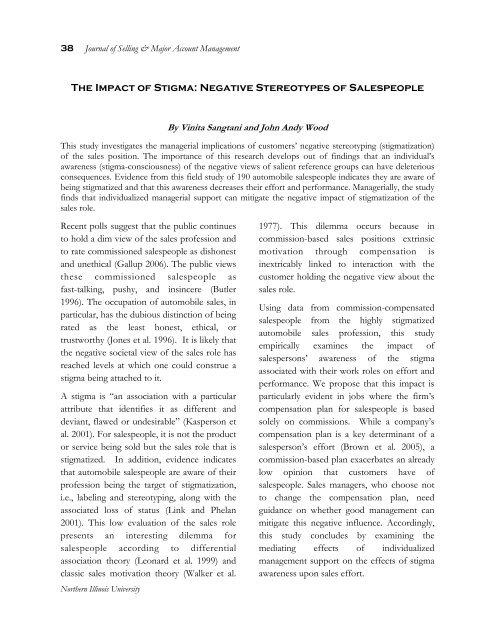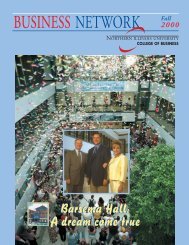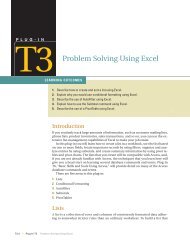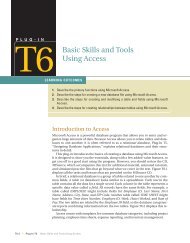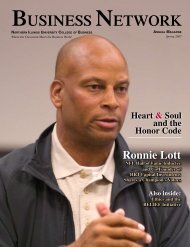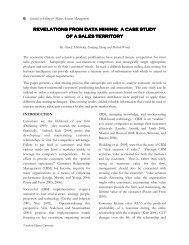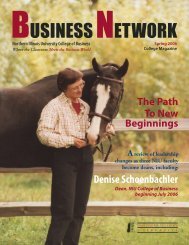The Impact of Stigma: Negative Stereotypes of Salespeople
The Impact of Stigma: Negative Stereotypes of Salespeople
The Impact of Stigma: Negative Stereotypes of Salespeople
Create successful ePaper yourself
Turn your PDF publications into a flip-book with our unique Google optimized e-Paper software.
38 Journal <strong>of</strong> Selling & Major Account Management<strong>The</strong> <strong>Impact</strong> <strong>of</strong> <strong>Stigma</strong>: <strong>Negative</strong> <strong>Stereotypes</strong> <strong>of</strong> <strong>Salespeople</strong>By Vinita Sangtani and John Andy WoodThis study investigates the managerial implications <strong>of</strong> customers’ negative stereotyping (stigmatization)<strong>of</strong> the sales position. <strong>The</strong> importance <strong>of</strong> this research develops out <strong>of</strong> findings that an individual’sawareness (stigma-consciousness) <strong>of</strong> the negative views <strong>of</strong> salient reference groups can have deleteriousconsequences. Evidence from this field study <strong>of</strong> 190 automobile salespeople indicates they are aware <strong>of</strong>being stigmatized and that this awareness decreases their effort and performance. Managerially, the studyfinds that individualized managerial support can mitigate the negative impact <strong>of</strong> stigmatization <strong>of</strong> thesales role.Recent polls suggest that the public continuesto hold a dim view <strong>of</strong> the sales pr<strong>of</strong>ession andto rate commissioned salespeople as dishonestand unethical (Gallup 2006). <strong>The</strong> public viewsthese commissioned salespeople asfast-talking, pushy, and insincere (Butler1996). <strong>The</strong> occupation <strong>of</strong> automobile sales, inparticular, has the dubious distinction <strong>of</strong> beingrated as the least honest, ethical, ortrustworthy (Jones et al. 1996). It is likely thatthe negative societal view <strong>of</strong> the sales role hasreached levels at which one could construe astigma being attached to it.A stigma is “an association with a particularattribute that identifies it as different anddeviant, flawed or undesirable” (Kasperson etal. 2001). For salespeople, it is not the productor service being sold but the sales role that isstigmatized. In addition, evidence indicatesthat automobile salespeople are aware <strong>of</strong> theirpr<strong>of</strong>ession being the target <strong>of</strong> stigmatization,i.e., labeling and stereotyping, along with theassociated loss <strong>of</strong> status (Link and Phelan2001). This low evaluation <strong>of</strong> the sales rolepresents an interesting dilemma forsalespeople according to differentialassociation theory (Leonard et al. 1999) andclassic sales motivation theory (Walker et al.Northern Illinois University1977). This dilemma occurs because incommission-based sales positions extrinsicmotivation through compensation isinextricably linked to interaction with thecustomer holding the negative view about thesales role.Using data from commission-compensatedsalespeople from the highly stigmatizedautomobile sales pr<strong>of</strong>ession, this studyempirically examines the impact <strong>of</strong>salespersons’ awareness <strong>of</strong> the stigmaassociated with their work roles on effort andperformance. We propose that this impact isparticularly evident in jobs where the firm’scompensation plan for salespeople is basedsolely on commissions. While a company’scompensation plan is a key determinant <strong>of</strong> asalesperson’s effort (Brown et al. 2005), acommission-based plan exacerbates an alreadylow opinion that customers have <strong>of</strong>salespeople. Sales managers, who choose notto change the compensation plan, needguidance on whether good management canmitigate this negative influence. Accordingly,this study concludes by examining themediating effects <strong>of</strong> individualizedmanagement support on the effects <strong>of</strong> stigmaawareness upon sales effort.
Academic Article Fall 2007 39BACKGROUNDBased upon expectancy theory whichunderlies the Churchill/Ford/Walkerframework (Johnston and Marshall 2003), afirm’s compensation structure, regardless <strong>of</strong>type, influences, through instrumentality(a probability estimate made by thesalesperson that performance leads to reward)<strong>of</strong> the salesperson, the motivation to expendeffort. <strong>The</strong>se estimates will have higherprobabilities when “salespeople arecompensated solely or partly bycommissions” (Walker et al. 1977 p. 165).Beyond an unspecific group <strong>of</strong> personal ororganizational variables, the other directantecedent <strong>of</strong> instrumentality is a salesperson’srole perception. More specifically, these roleperceptions are seen as the accuracy withwhich the salesperson understands thelinkages between performance and rewards,such as, understanding that compensation isdirectly tied to transactions. Role accuracyalso influences expectancies (probabilityestimates about effort leading to performance)such as, courteous behavior increases thechances <strong>of</strong> a successful sale.Many perceptions <strong>of</strong> salespeople about theirsales role come from ‘role partners’ (Johnstonand Marshall 2003). <strong>The</strong>se partnerscommunicate their expectations about thesales role. Evidence indicates one such rolepartner is the sales manager who can have apositive mediating influence between asalesperson's effort and performance (Boles etal. 1997; Brashear et al. 2003) throughmanaging role expectations. However, thesefindings about managerial support are limitedby a paucity <strong>of</strong> investigations into theinfluence <strong>of</strong> sales management on effort andperformance in commission-basedcompensation systems.This limitation is likely a development <strong>of</strong> thestream <strong>of</strong> research based upon the Andersonand Oliver (1987) framework. <strong>The</strong> AOframework provides several alternativetheories to explain salary or behavior-basedcompensation systems as more motivating <strong>of</strong>salespeople. Some support has been found toindicate that salary-based compensationcoupled with behavior-based control leads toincreases in sales effort and ultimately theperformance <strong>of</strong> salespeople (Cravens et al.1993; Oliver and Anderson 1994).Subsequently, most recent sales researchfocuses on behavior-based control systems(Baldauf et al. 2005). Little additional researchseemed necessary as salespeople fullycompensated by commission are conceptually,agents, and under agency theory, areextrinsically motivated by monetary reward(Ghosh and John 2000).We suggest, as do Cravens et al. (1993), thatthe outcomes <strong>of</strong> the choice <strong>of</strong> compensationstructure are more complex, especially whenconsidered along with role perceptions <strong>of</strong>salespeople. This being said, after choosingcommission-based compensation along withits specific structure, sales management’soptions to motivate are seemingly limited.This is because, even though Oliver andAnderson (1994) explicitly viewedcompensation directly tied to sales or pr<strong>of</strong>itsas only a part <strong>of</strong> an outcome-based controlsystem, they note the importance <strong>of</strong>commissions in practice: “under such asystem, the invisible hand <strong>of</strong> the marketplaceVol. 7, No. 4
40 Journal <strong>of</strong> Selling & Major Account Managementpressures salespeople to perform and guidestheir actions” (Anderson and Oliver 1987p. 76). Thus in the AO framework,salespeople primarily compensated bycommissions are, at a conceptual level,controlled by the marketplace and not by theirmanagers.However, we suggest, even though the choice<strong>of</strong> commission-based compensation guidessalespersons to exert effort at tasks they viewas necessary to achieve the sale, the role <strong>of</strong>management is not eliminated. Under theChurchill/Ford/Walker framework,management can indirectly influencemotivation by influencing role accuracyperceptions. Managers, as role partners, canand do influence instrumentality andexpectancy estimates that lead to effort toachieve the monetary reward. However,before establishing the influence <strong>of</strong> managers,it is important to first establish thatsalespeople do perceive that their efforts willdirectly lead to increased performance. Wetest this in the first hypothesis.H 1 : A salesperson’s perceived effort ispositively related to the salesperson’sself-reported performance.<strong>Stigma</strong> and EffortOne management challenge that developsunder outcome-based compensation systemsis to maintain sale’s focus on completing thetransaction while keeping a customerorientation. <strong>The</strong> literature has seen extensiveexamination <strong>of</strong> the effect <strong>of</strong> salespersonorientation on completing the sales task(Periatt et al. 2004). In the expectancyframework, salespersons will expend effort onthose tasks that they believe increase theprobability <strong>of</strong> a successful sales transaction.Customer-oriented salespeople see that theirefforts in taking care <strong>of</strong> the customer will leadto completion <strong>of</strong> the transaction (Saxe andWeitz 1982). Other salespeople may favorexpending effort on other actions, such asdeception, that they believe will enhance theprobability <strong>of</strong> a successful transaction andthus earn their commission. <strong>The</strong>se lattersalespeople engage in behaviors thataccomplish the goal regardless <strong>of</strong> customerinterests.It is likely that part <strong>of</strong> the stigma associatedwith commission-based salespeople stemsfrom the actions <strong>of</strong> a group thatunscrupulously engages in any behavior thatcompletes the transaction. However, undercertain conditions, even salespersons withan initial customer focus may find that thecommission-based compensation systemnegatively influences their effort andperformance. This can occur because, asnoted in differential association theory, thecustomer becomes a member <strong>of</strong> a criticalreference group or a role partner (Leonardet al. 1999). <strong>The</strong> customer’s opinions andwords will influence the salesperson's socialidentity, role perceptions, and motivation.Evidence suggests that when a salientreference group, such as the customer to thesalesperson, holds significant negative views<strong>of</strong> the salesperson, this condition willnegatively influence the salesperson’s workmotivation and effort (Leonard et al. 1999)This occurs when salespeople perceive theirinteractions with customers to be affectedby the stereotyping (Pinel 2004).Northern Illinois University
Academic Article Fall 2007 41Many commission-compensated salespeoplemay feel they are left with only two choices.<strong>The</strong>y may perceive that they are stigmatizedand discount the likelihood <strong>of</strong> a successful saleoutcome as a consequence <strong>of</strong> the stigmaassociated with their sales position. Thischoice leads to lower effort. <strong>The</strong> secondchoice is to discount or ignore the opinions <strong>of</strong>the customer and focus on completing thetransaction. This strategy may lead toincreases in negative opinions as customersperceive the salesperson is unconcerned withtheir needs. As we suggest next, eventuallythis leads to negative stereotyping <strong>of</strong> thiscategory <strong>of</strong> salespeople or the stigmatization<strong>of</strong> commission-based sales.Our understanding <strong>of</strong> stigmas, as a conditionthat influences interpersonal interactions,comes from the social sciences in general andmarketing in particular (Adkins and Ozanne2005; Link and Phelan 2001). While aconsensus definition <strong>of</strong> stigmatization iselusive, we propose that stigmatization is thecategorization <strong>of</strong> the sales role into astereotyped group and refers to patterns <strong>of</strong>social rejection. Most stigma frameworks(Adkins and Ozanne 2005; Link and Phelan2001) embrace a social explanation forrejection. Signs <strong>of</strong> stigmatization includeexistence <strong>of</strong> an outward indicator <strong>of</strong> class,negative connotations attached to thestereotyped category, and wide dissemination<strong>of</strong> the stigma through popular media.An additional component <strong>of</strong> stigmatization isthat the target <strong>of</strong> this stereotyping must beaware <strong>of</strong> the negative categorization for it tohave an impact on self-image (Oyserman andSwim 2001). It is likely that automobilesalespeople are aware <strong>of</strong> the negative societalconnotations associated with their pr<strong>of</strong>ession.Some evidence <strong>of</strong> this awareness is providedby salespeople’s widespread use <strong>of</strong>euphemisms for their pr<strong>of</strong>ession such as‘account manager’ or ‘problem solver’ in orderto cast the pr<strong>of</strong>ession in a more positive light(Blitzer 1994).A salesperson may or may not react to thestigma depending upon their choices outlinedabove. <strong>The</strong>y may ignore customers and theiropinions, in which case the stigmatizationdoes not matter. Alternatively, thesalesperson may maintain a customerorientation. <strong>The</strong>n, the salesperson’sperception <strong>of</strong> stigmatization is likely to be asignificant influence on the effort expendedsince the negative categorization comes fromthe role referent customer. <strong>Stigma</strong>consciousness theories suggest that awareness<strong>of</strong> stigmatization prevents the target <strong>of</strong> thestigma from “push(ing) themselves to excel inthat domain” (Pinel et al. 2005 p. 486). In asimilar vein, Bussey and Bandura (1999)maintain that targets <strong>of</strong> the stigma may lowertheir effort. This effect leads to our secondhypothesis:H 2 : A salesperson’s stigma-consciousness isinversely related to the salesperson’sself-reported effort.Manager SupportAs boundary spanners, salespeople must try tosatisfy both, customers and the company,which can cause role conflict for thesalesperson (Bagozzi 1980; Johlke and Duhan2001; Singh 1993). In addition, having to faceconstant rejection in selling, salespeople haveVol. 7, No. 4
42 Journal <strong>of</strong> Selling & Major Account ManagementFigure 1: Mediating Role <strong>of</strong> Effort and Manager SupportH2: negative H1: positive<strong>Stigma</strong>-consciousness Effort PerformanceManagers Supportto be self-motivated in order to be successful(Rich 1999). Self-guidance is particularlyimportant for commission-compensatedsalespeople. Under outcome-basedcompensation control and according to theagency theory perspective, this internalassurance is not likely to be bolstered by thesales manager.However, the sales manager plays a criticalrole in the salesperson’s performance inbuilding skills through coaching and training.In this role the sales manager is anothercritical referent source that influences thesalesperson’s perceptions about work(Leonard et al. 1999). Managers can alsoexert influence by providing individualizedsupport by way <strong>of</strong> personalized attention andby being empathetic to the feelings <strong>of</strong> thesalesperson. Personal support by managers,according to Dubinsky (1999), refers topersonal attention given to salespersons inindividual interactions and showing concernfor their well-being as well as theirpr<strong>of</strong>essional development. This supportprovided by the sales manager can contributeto the salesperson’s successful performance <strong>of</strong>the expected work roles (Johlke and Duhan2001).In this model, because <strong>of</strong> the inclusion <strong>of</strong>stigma, we suggest that managerial supportindirectly influences the salesperson’sperceptions <strong>of</strong> performance and more directlyinfluences the perceived effort exerted by thesalesperson. As our discussion in the previoustwo hypotheses indicates, research shows thatthe relationship between managerial supportand effort is reciprocal, i.e., managerialsupport can increase effort and vice versa(c.f. Luk and Shaffer 2005; Johlke and Duhan2001). Thus, we expect managerialsupport to mediate the internal assessmentprocesses <strong>of</strong> the salesperson. Managerialsupport, even in an outcome-based controlsystem, can mediate and decrease theinfluence <strong>of</strong> stigmatization on effort.Accordingly, we hypothesize:H 3 : Sales manager support will mediate thenegative influence <strong>of</strong> stigma-consciousness onself-reported effort.Northern Illinois University
44 Journal <strong>of</strong> Selling & Major Account Management40.00%Table 1Distribution <strong>of</strong> Sample Demographics30.00%20.00%10.00%0.00%1 2 3 4 5CategoriesAgeYears in SalesIncomeYears in Auto SalesYears in Auto Sales with this DealerCategory RangeAge25 years andunder26 -35 36 - 45 46 - 55 56 years andgreaterIncome$20,000 andunder$20,001-$40,000$40,001-$60,000$60,000-$80,000$80,001 andgreaterYears in Sales1 year and underGreater than 1to 5 yearsGreater than 5to10 yearsGreater than10 to15 yrs.Greater than15 yearsYears in AutoSales1 year and underGreater than 1to 5 yearsGreater than 5to10 yearsGreater than10 to15 yrs.Greater than15 yearsYears in AutoSales with thisDealer1 year and underGreater than 1to 5 yearsGreater than 5to10 yearsGreater than10 to15 yrs.Greater than15 yearsconsciousness affects interactions <strong>of</strong> targetgroup members, in this case automobilesalespersons, with those not belonging to thetarget group. <strong>The</strong> five items in Appendix 1were used for the analysis.Manager Support (0.92): Individualizedmanager support reflected the sales manager’srespect and “concern about their (thesalespersons’) personal feelings andneeds,” (Rich 1999 p.55). This direct supportfor the individual is measured by five items.Effort (0.87): Measures <strong>of</strong> the salesperson’seffort can incorporate self-evaluation orexternal supervisory indicators. As stigma islikely to affect self-reported effort orperformance, those types <strong>of</strong> indicators areused. <strong>The</strong> five items used by Dixon et al.Northern Illinois University
Academic Article Fall 2007 45(2001) to measure salespeople’s effortattribution measured the effort <strong>of</strong> salespeoplein this study.Performance (0.93): Sujan et al’s (1994)seven item performance scale reflectssalespeople’s evaluation <strong>of</strong> their attainment <strong>of</strong>company objectives. It captures subjectivecomparisons <strong>of</strong> their performance withthat <strong>of</strong> colleagues’. Adaptations were madeto capture the automobile sales contextwith the final scale having the eight itemslisted in appendix 1.RESULTSAs anticipated, salespersons’ perceptions <strong>of</strong>their effort are positively related to theirself-reported performance. Regressingperformance on effort indicates supportfor hypothesis one as the beta coefficient<strong>of</strong> .178 is statistically significant at p
Academic Article Fall 2007 47compensation system. However, given theoutcome-based versus process-based controlsystem, it is likely that unscrupulousindividuals looking for low control may selfselect the commission-based compensationsystem. This self selection leads to a higherproportion <strong>of</strong> ‘sales oriented’ and/oropportunistic individuals in outcome-basedcompensation systems.Management is faced with the dilemma <strong>of</strong>avoiding outcome-based compensation oraccepting the possibility that customers willhave some negative views about the sales role.This study suggests other options tomanagement for avoiding unethical behaviorsand resultant stigmatization beyond usingoutcome-based compensation. As we outlinenext, an integrated series <strong>of</strong> sales managementpractices could alleviate some <strong>of</strong> the moredeleterious consequences <strong>of</strong> stigmatization <strong>of</strong>the sales pr<strong>of</strong>ession.Our first recommendation is that managersshould not ignore or discount the possibilitythat a stigma is associated with their firm’s salespositions. When using commission-based salescompensation, it is important to determine ifyour sales people feel customers hold negativeviews about the sales position. Care should betaken to ensure that the salespeople areexpressing their opinion about the position andnot customer opinions about them asindividuals. It is quite possible that thesalesperson could reason that the customerdoesn’t hold a positive opinion <strong>of</strong> the sales rolebut thinks quite highly <strong>of</strong> them. <strong>The</strong> questionsincluded in the stigma scale, in the appendix tothis paper, are a good guide to the questions amanager should ask <strong>of</strong> sales people.Sales managers can confirm the influence <strong>of</strong>stigma consciousness by querying theirsalespeople about the sales process. Managersshould seek to identify any role inaccuraciesthat may be the result <strong>of</strong> stigmatization.Managers should look for inaccurate estimates<strong>of</strong> the amount and types <strong>of</strong> effort necessary toachieve a successful transaction. Managersshould also look for inaccuracies in estimates<strong>of</strong> the reward achieved for a successful sale. Asalesperson that overestimates the effortrequired to complete a sale or incorrectlyestimated the reward earned by a sale that hasalso expressed stigma-consciousness indicatesa problem.<strong>The</strong> second step for the manager is todetermine if, in the aggregate, there areenough salespeople aware <strong>of</strong> customerstigmatization. Managers are cautioned toremember that not all salespeople will expressawareness <strong>of</strong> the stigma even if it exists.<strong>Salespeople</strong> have coping mechanisms to dealwith the stigma and thus may not exhibit aconsciousness <strong>of</strong> the stigma. A cautionarynote about one coping mechanism is in order.A focused qualitative study found that someautomobile salespeople cope by reversing theroles and stigmatizing the customers as theinferior group with negative characteristics(Felcher 1995). This particular copingmechanism may require extensive retraining toavoid it devolving into deceitful andopportunistic behaviors.For the sales manager, the most importantgroup is the salespeople that express anawareness <strong>of</strong> the stigma. <strong>The</strong> results <strong>of</strong> thisstudy indicate that managers can mediate theeffects <strong>of</strong> stigmatization on effort. <strong>The</strong> key isVol. 7, No. 4
48 Journal <strong>of</strong> Selling & Major Account Managementin recognizing that stigma applies to the salesrole and not the individual. Again looking atthe appendix at the end <strong>of</strong> the paper (see theitems measuring manager support), one seesthe emphasis is upon supporting theindividual and not the sales task. Managersneed to acknowledge the stigma but point outthat it is not personally directed. Managementdoes not need to expend efforts on buildingup the sales role. Rather, managers shouldfocus on the individual. Management effortto spend time with each salespersonindividually (the management literature <strong>of</strong>tencites three times a week) as opposed to timespent in group meetings will have benefits.Coupling this management time withindividualized training in coping techniqueswill lead to extensive improvements in effort.Measuring the success <strong>of</strong> managementsupport is also relatively simple. <strong>The</strong> effect <strong>of</strong>management intervention should becomeevident through more accurate roleperceptions. <strong>Salespeople</strong>’s estimates <strong>of</strong> theprobability <strong>of</strong> success based on effort shouldbecome more closely aligned with the firm’sexperience. Similarly, accuracy in roleperceptions will be indicated by how close thesalesperson’s estimate <strong>of</strong> the specific rewardfrom a successful sale is to the company’sactual calculation <strong>of</strong> compensation. Thus,managers can query the salespeople bothbefore about their role accuracy as adiagnostic <strong>of</strong> potential problems and aftersome management intervention forindications <strong>of</strong> successful mediation.Another possible implication <strong>of</strong> stigmatizationis its consequence on effort. Low motivationto exert sales effort will have a negative impactNorthern Illinois Universityon performance. Pinel et al (2005) suggestthat the decrease in effort by highlystigma-conscious people might occur due to“psychological disengagement,” a process <strong>of</strong>distancing the self from the domain in whichthe stigmatization is experienced. Thisdisengagement may be a partial explanationfor the high voluntary turnover <strong>of</strong> automobilesalespeople. A cycle <strong>of</strong> low estimates aboutobtaining the commission followed by lowsuccess rates creates the self-fulfillingexpectancy leading ultimately to low income.Management engagement might break thiscycle and decrease turnover.As a final recommendation, management canhelp salespeople disconfirm the customer’sexpected stereotype. First impressions canconfirm or disconfirm expectations and thesebegin with the introduction <strong>of</strong> the customerand salesperson (Wood 2006). Educatingsalespeople on the appropriate display <strong>of</strong>initial nonverbal signals can have a hugeimpact on the balance <strong>of</strong> the customer/salesperson interaction. Handshakes, eyecontact, and genuine smiles begin therelationship on a positive note and are morethan a formality. Managers should be aware <strong>of</strong>the impact <strong>of</strong> these displays and role play withtheir salespeople to practice non-verbals. Thistraining is an example <strong>of</strong> the individualizedattention mentioned above.LIMITATIONS AND FUTURERESEARCHThis research just scratches the surface <strong>of</strong> aneglected area in the sales literature, namelythe effect <strong>of</strong> society's negative stereotyping <strong>of</strong>the sales pr<strong>of</strong>ession. Because this researchuses automobile salespeople in a deliberate
Academic Article Fall 2007 49attempt to maximize stigmatization and tomaintain a commission-based compensationcontext, caution should prevail when drawingany broad conclusions. However, thisresearch is an extension <strong>of</strong> an establishedframework <strong>of</strong> motivated salespeopleexpending more effort which leads toincreases in performance. <strong>The</strong> papercontributes to our understanding <strong>of</strong>motivation by finding stigmatization impedesthis effort. Of course, other factors such assalespeople’s personal characteristics,experience with selling, and/or the type <strong>of</strong>selling situation also influence themotivation-effort-performance model and thedeliberate exclusion <strong>of</strong> positive influences is alimitation <strong>of</strong> this study. This limitation couldbe alleviated by additional research. Inaddition, while it appears likely that regardless<strong>of</strong> compensation structure the presence <strong>of</strong>stigma may negatively influence sales effortand performance, investigation <strong>of</strong> thisconclusion needs to continue. Extensions <strong>of</strong>this line <strong>of</strong> research are imperative, as it is notlikely that the negative opinions <strong>of</strong> salespeoplewill disappear any time soon.Another fruitful line <strong>of</strong> investigation would beto see if salespeople were conscious <strong>of</strong> thestigma prior to starting the job. Futurelongitudinal studies would investigate if thelevels <strong>of</strong> stigma consciousness had changedsince starting employment. Research mightreveal additional factors that mediate theinfluence <strong>of</strong> the stigmatization. However,since the salespeople in our sample had beenat their current dealership for an average <strong>of</strong>over five years, their tenure would likely havebiased their previous recollections <strong>of</strong> stigma;consequently, we did not measure their stigmaconsciousness prior to entering thepr<strong>of</strong>ession.Despite these various shortcomings it is clearthat managers can mediate the effect <strong>of</strong>stigma. This managerial influence upon fullycommissioned salespeople is another underexplored area in the literature. <strong>The</strong>implication that sales positions that primarilyrely upon monetary rewards for motivationcan also motivate sales effort by 's<strong>of</strong>t' factorssuggest a hybrid system <strong>of</strong> control where theinfluences <strong>of</strong> monetary rewards are monitoredby managers. Research into such hybridsystems is likely to be fruitful. Finally, thisresearch needs to extend into differentcontexts, such as, services or business tobusiness sales.REFRENCESAdkins, Natalie Ross and Julie L. Ozanne(2005), "<strong>The</strong> Low Literate Consumer,"Journal <strong>of</strong> Consumer Research, 32 (2), 93-105.Anderson, Erin and Richard L. Oliver (1987),"Perspectives on Behavior-BasedVersus Outcome-Based SalesforceControl Systems," Journal <strong>of</strong>Marketing, 51 (October), 76-88.Bagozzi, Richard P. (1980), "<strong>Salespeople</strong> and<strong>The</strong>ir Managers: An Exploratory Study<strong>of</strong> Some Similarities and Differences,"Sloan Management Review, 21 (2), 15-26.Baldauf, Artur, David W. Cravens, andNigel F.Piercy(2005),"Sales ManagementControl Research-Synthesis and anAgenda for Future Research," Journal <strong>of</strong>Personal Selling & Sales Management, 25(1), 7-26.Vol. 7, No. 4
50 Journal <strong>of</strong> Selling & Major Account ManagementBaron, Reuben M. and David A. Kenny (1986),"<strong>The</strong> Moderator-Mediator VariableDistinction in Social PsychologicalResearch: Conceptual, Strategic andStatistical Considerations," Journal <strong>of</strong>Personality and Social Psychology, 51 (6),1173-82.Bernstein, Marty (2003), "Car <strong>Salespeople</strong>, AdExecs Rank Low in Poll,” AutomotiveNews, 77 (6039), 3M.Blitzer, Roy J. (1994), "From Trainer toSalesperson," Training & Development, 48(7), 58-59.Boles, James S., Mark W. Johnston, and Jr Joe F.Hair (1997), "Role stress, Work-FamilyConflict and Emotional Exhaustion,"<strong>The</strong> Journal <strong>of</strong> Personal Selling & SalesManagement, 17 (1), 17.Brashear, Thomas G., James S. Boles, Danny N.Bellenger, and Charles M. Brooks (2003),"An Empirical Test <strong>of</strong> Trust-BuildingProcesses and Outcomes in SalesManager-Salesperson Relationships,"Journal <strong>of</strong> Academy <strong>of</strong> Marketing Science, 31(2), 189-201.Brown, Steven P., Kenneth R. Evans, Murali K.Mantrala, and Goutam Challagalla(2005), "Adapting Motivation, Control,and Compensation Research to a NewEnvironment," Journal <strong>of</strong> Personal Selling& Sales Management, 25 (2), 155-67.Bussey, Kay and Albert Bandura (1999), "SocialCognitive <strong>The</strong>ory <strong>of</strong> GenderDevelopment and Differentiation,"Psychological Review, 106 (4), 676-713.Butler, Charles (1996), "Why the Bad Rap?," Sales andMarketing Management, 158 ( 6), 58-67.Cravens, David W., Ingram Thomas N.,Raymond W. LaForge, and Clifford E.Young (1993), "Behavior-Based andOutcome-Based Salesforce ControlSystems," Journal <strong>of</strong> Marketing, 57 (4), 47-59.Dixon, Andrea L., Roseann L. Spiro, and MaqbulJamil (2001), "Successful andUnsuccessful Sales Calls: MeasuringSalesperson Attributions and BehavioralIntentions," Journal <strong>of</strong> Marketing, 65 (3), 64-78.Northern Illinois UniversityDubinsky, Alan (1999), "Sales Person Failure:Sales Management is the Key," IndustrialMarketing Management, 28 (1), 7-17.Felcher, Marla (1995), ""Pr<strong>of</strong>essors", "Get MeDones", and "Moochers": How Car<strong>Salespeople</strong> Experience <strong>The</strong>irCustomers," Advances in ConsumerResearch, 22, 611-16.Gallup, Organization (2006), "Honesty / Ethicsin Pr<strong>of</strong>essions," Vol. 2007.Ghosh, Mrinal and George John (2000),"Experimental Evidence on AgencyModels <strong>of</strong> Salesforce Compensation,"Marketing Science, 19 (4), 348-65.Joetan, Edwin and Brian H. Kleiner (2004),"Incentive Practices in the USAutomobile Industry," ManagementResearch News, 27 (7), 49-56.Johlke, Mark C. and Dale F. Duhan (2001),"Supervisor Communication Practicesand Boundary Spanner Role Ambiguity,"Journal <strong>of</strong> Managerial Issues, 13 (1), 87-101.Johnston, Mark W. and Greg W. Marshall(2003), Churchill/Ford/Walker'sSalesforce Management (Seventh ed.).Boston: McGraw Hill.Jones, Eli, Donna Massey Kantak, Charles M.Futrell, and Mark W. Johnston (1996),"Leader behavior, work-attitudes, andturnover <strong>of</strong> salespeople: An IntegrativeStudy," <strong>The</strong> Journal <strong>of</strong> Personal Selling &Sales Management, 16 (2), 13.Kasperson, Roger. E., Natalie Jhaveri, andJeanne X. Kaperson (2001), "<strong>Stigma</strong>,Places, and Social Amplification <strong>of</strong> Risk:Toward a Framework <strong>of</strong> Analysis," inRisk, Media, and <strong>Stigma</strong>: UnderstandingPublic Challenges to Modern Scienceand Technology, J. Flynn and P. Slovicand H. Kunreuther, Eds. London:Earthscan.
Academic Article Fall 2007 51Leonard, Nancy H., Laura L. Beauvais, andRichard Scholl (1999), "WorkMotivation: <strong>The</strong> Incorporation <strong>of</strong>Self-Concept-Based Processes," HumanRelations, 52 (8), 969-98.Link, Bruce G. and Jo C. Phelan (2001),"Conceptualizing <strong>Stigma</strong>," AmericanSociological Review, 27, 363-85.Luk, Dora M. and Margaret A. Shaffer (2005),"Work and Family Domain Stressorsand Support: Within and Cross-DomainInfluences on Work-Family Conflict,"Journal <strong>of</strong> Occupational and OrganizationalPsychology, 78 (4), 489-508.Oliver, Richard L. and Erin Anderson (1994),"An Empirical Test <strong>of</strong> the Consequences<strong>of</strong> Behavior and Outcome Based SalesControl Systems," Journal <strong>of</strong> Marketing, 58(4), 53-67.Oyserman, Daphna and Janet K. Swim (2001),"<strong>Stigma</strong>: An Insider's View," Journal <strong>of</strong>Social Issues, 57 (1), 1-14.Periatt, Jeffery A., Stephen A. LeMay, and SubraChakrabarty (2004), "<strong>The</strong> SellingOrientation-Customer Orientation(SOCO) Scale: Cross Validation <strong>of</strong> theRevised Version," Journal <strong>of</strong> PersonalSelling & Sales Management, 24 (1), 49-54.Pinel, Elizabeth C. (1999), "<strong>Stigma</strong>Consciousness: <strong>The</strong> PsychologicalLegacy <strong>of</strong> Social <strong>Stereotypes</strong>," Journal <strong>of</strong>Personality and Social Psychology, 76 (1), 114-28.Pinel, Elizabeth C., Leah R. Warner, andPoh-Pheng Chua (2005), "Getting <strong>The</strong>reis Only Half the Battle: <strong>Stigma</strong>Consciousness and MaintainingDiversity in Higher Education," Journal <strong>of</strong>Social Issues, 61 (3), 481-506.Pinel, Elizabeth C. (2004), "You're Just SayingThat Because I'm a Woman: <strong>Stigma</strong>Consciousness and Attributions toDiscrimination," Self and Identity, 3 (1), 39-51.Rich, Gregory A. (1999), "SalespersonOptimism: Can Sales Managers EnhanceIt and So What if <strong>The</strong>y Do?," Journal <strong>of</strong>Marketing <strong>The</strong>ory and Practice (Winter), 53-63.Saxe, Robert and Barton A. Weitz (1982), "<strong>The</strong>SOCO Scale: A Measure <strong>of</strong> CustomerOrientation <strong>of</strong> <strong>Salespeople</strong>," Journal <strong>of</strong>Marketing Research, 19 (August), 343-51.Singh, Jagdip (1993), "Boundary Role Ambiguity:Facts, Determinants, and <strong>Impact</strong>s,"Journal <strong>of</strong> Marketing, 57 (2), 11-31.Sujan, Harish, Barton A. Weitz, and NirmalyaKumar (1994), "Learning Orientation,Working Smart, and Effective Selling,"Journal <strong>of</strong> Marketing, 58 (3), 39-52.Walker, Orville C., Jr., Gilbert A. Churchill Jr.,and Neil M. Ford (1977), "Motivationand Performance in Industrial Selling:Present Knowledge and NeededResearch," Journal <strong>of</strong> Marketing Research,14 (May), 156-68.Wildermuth, Susan M. (2004), "<strong>The</strong> Effects <strong>of</strong><strong>Stigma</strong>tizing Discourse on the Quality <strong>of</strong>On-Line Relationships," CyberPsychology& Behavior, 7 (1), 73-84.Wood, John Andy (2006), "NLP Revisited:Nonverbal Communications and Signals<strong>of</strong> Trustworthiness," Journal <strong>of</strong> PersonalSelling & Sales Management, 26 (2), 197-204.Vinita Sangtani(Ph.D. Georgia State University)Assistant Pr<strong>of</strong>essor <strong>of</strong> MarketingDepartment <strong>of</strong> Management & MarketingNicholls State UniversityVinita.Sangtani@nicholls.eduJohn Andy Wood(Ph.D. Georgia State University)Assistant Pr<strong>of</strong>essor <strong>of</strong> MarketingCollege <strong>of</strong> Business and EconomicWest Virginia Universityjawood@mail.wvu.eduVol. 7, No. 4
52 Journal <strong>of</strong> Selling & Major Account ManagementAPPENDIX 1MeasuresPerformance (Sujan, Weitz and Kumar 1994):1. At contributing to my dealerships acquisition <strong>of</strong> market share2. At selling high pr<strong>of</strong>it margin products3. At generating a high volume <strong>of</strong> sales dollars4. At quickly generating sales <strong>of</strong> new additions to my dealerships inventory5. At correctly identifying prospects6. At converting prospects to customers7. At exceeding sales targets8. At assisting the sales manager at achieving his or her goalsManager Support (Rich 1999):1. Demonstrates he/she genuinely cares about me2. Shows respect for my individual needs3. Shows respect for my individual feelings4. Usually trusts me to do the right thing5. Treats me like a real person, not a subordinate<strong>Stigma</strong> Pinel (1999), Wildermuth (2004), Pinel (2004), and Pinel et al. (2005):1. <strong>Stereotypes</strong> about automobile salespersons have not affected me personally2. I never worry that my behaviors will be viewed as stereotypically that <strong>of</strong> an automobile salesperson3. Most <strong>of</strong> my friends do not judge me on the basis <strong>of</strong> being an automobile salesperson4. It never crossed my mind that my pr<strong>of</strong>ession is any less than other pr<strong>of</strong>essions5. When others speak disapprovingly <strong>of</strong> automobile salespersons, I criticize myself about being one.Effort (Dixon, Spiro, Jamil 2001):1. I worked hard and it paid <strong>of</strong>f2. I tried very hard to make this sale3. I put in a lot <strong>of</strong> effort in this sale4. I put in the time needed to make the sale5. I gave the effort needed to make the saleNorthern Illinois University


